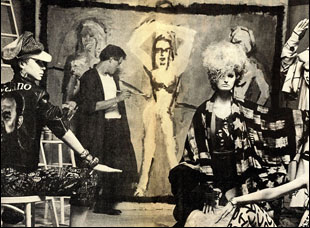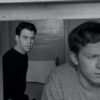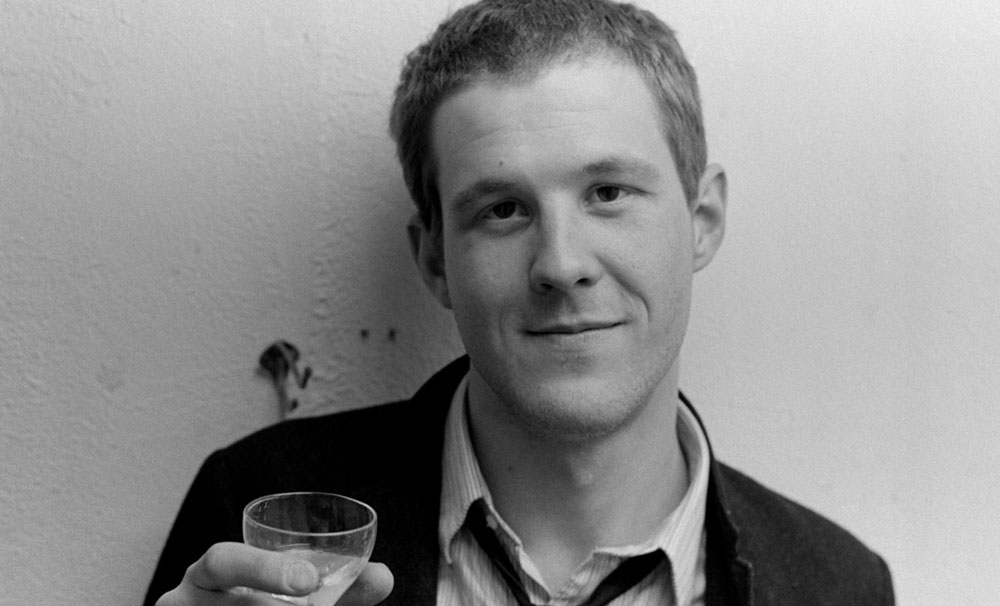If Brian Vincent was going to be true to the subject of his documentary, “Make Me Famous,” he knew he couldn’t take no for an answer in putting together an accurate portrait of Edward Brezinski’s life. This might’ve made things even more difficult for the filmmaker on his first nonfiction project, particularly when some might be loathe to speak about the painter, who had earned a reputation for his exploits in the New York art scene during the early 1980s more than his actual works by trying to get noticed at gallery openings of more famous artists such as Jean-Michel Basquiat and Keith Haring and passing out leaflets promoting his own shows. But Vincent had to appreciate the fact that if it weren’t for Brezinski’s persistence at the time, there would even be less of a chance he’d know his work today — vital portraits of people in the community around him during that most exciting moment in the city’s cultural history that would eventually become screams for help during the AIDS crisis that began to ravage it — so when it came to approaching Robert Gober, who Brezinski infamously mocked by eating a sculpted donut in one of his exhibits, the standard “no comment” wasn’t about to be the last word.
“You know we did this project for 10 years and his schedule was really full,” Vincent laughs now of getting crafty to get Gober on the record about the incident, in which the joke ultimately was on Brezinski when the donut had been finished in resin that sent him to the hospital. “But the way that I figured that one out was he was giving a talk at the Museum of Modern Art, and they had recreated the exact scene of the donut and everything, so I was in the audience and I asked him a question.”
From “Make Me Famous,” it seems like there are no lengths that Vincent and his partner Heather Spore Kelly wouldn’t go to get to the bottom of Brzezinski’s story, revealing in the process a number of artists who didn’t get their due during such a creatively fertile period in the Lower East Side. Brezinski could see the future coming in more ways than one, not only specializing in the kind of stencil art that could later be seen as a progenitor for agitators such as Banksy and Mr. Brainwash, but opening up his apartment as a gallery space called Magic where his work could be seen along other noteworthy artists who weren’t yet acknowledged as such, with the place christened by no less than a poetry reading by the poet and playwright Miguel Piñero. Thanks to the filmmakers’ dogged determination, there is actually footage from these openings to place one squarely in the middle of the action, but little could the two know that they would end up there themselves when Brzezinski may have been pronounced dead in 2007, but there are clues that the wily Neo-Expressionist might still be active in Europe and coupled with a commemoration of the Club 57 scene of which Brezinski was a major part at MoMA in 2018, the film ends up being far less retrospective than anyone could’ve predicted.
Whether or not Bresinzki is found alive and well, “Make Me Famous” brings the artist to life vividly with the candid recollections one might expect from the old punks he ran with that once ruled St. Marks Place and the art itself with its blazing colors and rebellious style and naturally, when getting the film out into the world, Vincent and Spore Kelly are doing it completely independently, following a successful festival run with a theatrical release in the U.S. starting this week in New York before expanding across the country, and graciously took the time to reflect on the film’s decade-long journey to the screen, following in their subject’s footsteps to win over a tetchy creative circle and the most unexpected places the story led to.

Brian Vincent: There’s been a couple of reviews where people say that I was a part of the scene in the ‘80s, and I actually wasn’t. I was 10 years old in Kansas City. [laughs] But I read a Cynthia Carr’s book “Fire in the Belly,” about David Wojnarowicz, and became obsessed with it. Lenny Kisko heard that I was obsessed with the ’80s art scene and he said, “Well, you have to come over to my apartment. I collected this artist all through the ’80s and you just have to see this work.” So I traipsed over there. He lives in a railroad apartment in Hell’s Kitchen and every surface is covered with a Brezinski painting, and I was just enthralled with the work. And I’m an actor and I was in between work and I just became obsessed with [Brezinski]. The research went on from 2012 through 2015 and we filmed all the way from 2015 until 2020.
Heather Spore Kelly: Honestly, we were first-time filmmakers and we didn’t know like what it entailed and how long it actually takes, but I think Brian had the tools to make the film from [his time at] Juilliard, because that’s the top acting school in the country and they teach you to be storytellers, and I’ve been on Broadway for over 10 years in “Wicked” and every night, [you’re] telling a story, starting from the beginning and telling it again, so it’s the same kind of vibe.
Brian Vincent: But artists are not like actors. If you tell an actor you’re working on a project, they’ll show up at your door the next day whereas with artists, they required that you chase them around a little bit. So we went to their openings. And Annina Nosei, for instance, who discovered Basquiat, I called her and she said she has a fantastic story about Brezinski, but [she asked me] “What do you know [already]?” And she had some books she wanted me to read [even before we could talk] and I did, so that process of getting to know these artists and getting them to trust us went on for three years, but I think that comes through in the movie that we actually really know them and they’re very relaxed when they’re doing their interviews.
One of my favorite things was actually just the backgrounds that you were able to get to film them in. How did you figured out what kind of spaces you’d shoot them in?
Brian Vincent: We were filming at a very large, beautiful studio, and I thought that it would be good if we could consistently put them in this same studio, but change the paintings of Brezinski in the background. Because the audience is unfamiliar with Brezinski’s work, they will see this work and they’ll hear about these stories and they’ll start to associate visually with these paintings as time goes along and that advantage happened because I had worked at a studio and that’s how I learned how to become a filmmaker. And we filmed at that studio.

Brian Vincent: Yes, some of the most thrilling parts of this movie for me personally was when Richard Hambleton was making paintings — to witness someone of his caliber [where] he could take a paintbrush and [with a few strokes] just go like this and a horse would appear and he’d say, “Well, I have 50 years in these hands, Brian.”
Heather Spore Kelly: But [Brian] met him at an event through the course of this film and wanted to interview him, and it took a while to get that interview. We were always chasing artists, and [Richard] was just in a situation where he needed some help, so he said, “Hey, Brian, if you bring me paint and some canvases, I can paint my way out of this.” And Brian [thought], “This would be a great way to research my documentary and also help this guy.”
It seems like such a sprawling story to tell when you have to explain the entire cultural scene to speak to Edward Brezinski’s story. Was it difficult to find a through line?
Brian Vincent: It was very challenging edit, partly because I thought that it couldn’t be presented in the same way that a lot of bios are presented because people didn’t know who Brezinski is. The framework of the documentary is to follow an archetypical artist of the time to get the feeling of what it’s like to be there in the ’80s. But because they don’t know his work yet, I felt that it would be better to begin the movie through the recollections of all of the artists who knew him, so the structure of the movie is presented through his obituary [at first] – and that was a breakthrough [for us], realizing that his obituary, though small, framed every important event of his career and eventually the obituary’s validity is questioned itself, so that became a way to reverse the story and create a new type of movie plot.
Heather Spore Kelly: It’s so rare that you have a biography of a non-famous artist, so Brian had to go at it different way, but he wanted that edit to have the energy of the period, and the subjects in the film feel like we really got it right, so that’s always a good compliment.
Brian Vincent: One of the main things was he has an obituary, but when I looked on the master death file, Edward wasn’t on it, so that definitely changed the movie and we were pursuing Edward [as a potentially alive person] throughout the time that we researched the movie. That took us to Berlin. It took us to the Cote d’Azur. It’s always nice if your subject goes to places you’d want to go. [laughs] But what was a reflective documentary became a live-action movie as we pursued him, and we have a friend in law enforcement who told me that the way to track a person is with three names [including their middle name]. There’s very few people in America with the same three names and we did locate a Edward James Brezinski in prison in Arizona, so we went through the process, but it wasn’t [our] Edward and that spun us in a different direction.
Heather Spore Kelly: Yeah, we were really beat. We got caught up in the true crime [narrative], finding out this guy’s history and several times along the way, we thought we had found him alive. There were a lot of twists and turns. In fact, right before we went to France to try to find out what really happened to him, we could find no record of him, so it was very exciting to be able to put a button on it and really find out what happened to this crazy artist.
You find some remarkable archival material as well, such as the videos from Brezinski’s makeshift gallery Magic in his apartment. What was it like to get your hands on?
Brian Vincent: That was a surprise that when we began the documentary. While we were researching, Heather said, “Look, I found something online. It looks like this is Edward Brezinski’s apartment where he was having his shows.” And sure enough, it was Miguel Pinero performing at Edward Brezinski’s opening, so I reached out to the person who had put up the video and it turned out his name is Jim C., a videographer who it turned out had filmed Edward Brezinski openings throughout his career, so that was one of the most exciting moments for us because we realized we could tell this story through the archival and help [audiences] live in this journey.
Did you know that MoMA would actually have an entire exhibit devoted to Club 57 while you were making this?
Brian Vincent: We were completely blown away when we found out through the artists that MoMA was doing a show. Edward Brezinski was one of the seminal first artists to show at Club 57, but we weren’t sure how to reach MoMA, so we made a five-minute video and asked the artists, “Could you share this with the curators?” One of them was interviewing with them, and he said he had a minute where the conversation had died down a little, so he said, “Have you heard about Edward Brezinski?” And they said, “Edward Brezinski?” And he said, “Yeah, I have a video.” So they saw this video and they loved it and we got to meet the curators, and then in fact, we arranged for them to meet a few of the artists, one of them being Richard Hambleton, so we became a part of this whole art history that happened. And the Club 57 show was incredible. They put two paintings of Edward’s in it.
What’s it been like to get this out into the world?
Heather Spore Kelly: It’s incredible. The pandemic gave us a lot of opportunity to grow our fan base. They always say “find your audience” and until you’ve made a film, you don’t really know what that means. But we started this Instagram group about the film and started collecting artists [as followers] and they were having real conversations on the page. We’ve really been selling this film out mainly from social media, but it’s been It’s been really exciting to get to know all the people involved and they just keep coming up with stories and enjoying the film. This film is really moving to people who have spent time in New York, [particularly that time] because it was a different time. Buildings were crumbling and it’s not like that anymore, but it was raw. That’s why the artists went down there on the Lower East Side and created this ecosystem of their own and they really owned it. That was inspiring for us.
Brian Vincent: And we started our journey [with the film] at NewFest in New York and they launched us into the stratosphere. We were able to play many festivals after that, and we’re an independent film and [I want] to reassure people out there that are filmmakers that you can make it this far. We don’t have distribution. We are doing this ourselves and we’ve produced this movie and the movie’s going into theaters and we’re making contacts with all these arthouse cinemas and you can do it directly because I think there’s been difficulty with the art cinemas getting audiences there. And Heather and I go out on the street and we meet people. We go to the theaters and that’s how we get our audience.
Heather Spore Kelly: Don’t tell them our secrets. [laughs]
Brian Vincent: Okay, sorry. [laughs] It’s not easy, but there is a pathway for independent films and we’re going to be the poster child for it.
“Make Me Famous” is now open in New York at the Roxy Cinema, the New Plaza Cinema and the Alamo Drafthouse Lower Manhattan and will open in Los Angeles at the Monica Film Center, the Claremont 5 and the Laemmle Glendale on July 10th.




